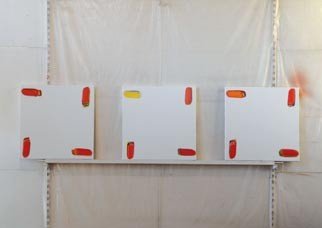Alix Le Meleder
dal 10/6/2008 al 22/7/2008
Segnalato da
10/6/2008
Alix Le Meleder
Galerie Zurcher, Paris
The artist offers a formal proposal that makes her stand out among the few painters of an abstract tendency currently working in France. Four coloured forms with imprecise borders are placed in immediate proximity to the corners of a white canvas, perpendicular to the edges.

Alix Le Méléder offers a formal proposal that makes her stand out among the few painters of an "abstract" tendency currently working in France. Four coloured forms with imprecise borders are placed in immediate proximity to the corners of a white canvas, perpendicular to the edges. Each of the forms is comprised of superimposed colour fields whose rectangular section is determined by the passage of the brush in the course of an intense process whose origin the artist recalls: "I realised, one day, that in my pictures there was a desire for expression, and I wanted to get beyond it. I had to obliterate myself, and the painting had to start off anew from colour (…) I felt the need to explode space more and more. This was how I came to the square format. And as a way of evading a sort of horizontal confrontation with the picture, I arrived at its rotation." [1]
The summation of different, imperfectly-covered colour fields after each rotation only ends when the tension that has authorised it arrives at a "breaking point". The artist is thus imprinting a "mark" whose sole function is to indicate its discreet presence in the manner of certain non-figurative prehistoric cave paintings – lines and smudges – with which Philippe Dagen sees a parallel. Le Méléder’s canvases "recall with unfailing force that the power of art – its only remaining power, by now – is to make manifest the distinctiveness of a human being who refuses to capitulate and disappear, whereas everything seems to condemn him to this elimination." [2]
A picture is finished; the next one can be started. The project is immense, unfathomable, ontological in its nature: hundreds of pictures, one after the other, drawn from the wellspring of humanness [3]. The "dripping" that produced the red patches in the canvases of the first generation has given way to chromatic fringes that can sometimes be of such luminous intensity as to dazzle.
Bernard Zürcher
Opening june 11, 2008
Galerie Zurcher
56, rue Chapon - Paris
Free admission



